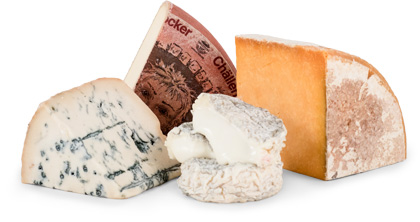Gorgonzola is a tangy blue cheese made in the northern Italian village of the same name, which is located on the outskirts of Milan. Legend has it that this cheese was first made there in 879 AD, though its exact date of origin still remains a mystery. There are some indications that the cheese might go even further back than the legend states – to the Romans. However, one should note that a lot of historic hyperbole often surrounds European cheeses. The important thing is not so much the history, but that this amazing cheese is around for us to enjoy today.
Gorgonzola is made with either unpasteurized or pasteurized milk to which a starter mold is added. At about four weeks the cheese is pierced with thick needles to encourage the spread of the mold. Gorgonzola comes in two varieties: the young, sweet dolce and the aged piccante (this month’s selection), which is matured for a period of at least 80 days. Its color ranges from white to straw-yellow with a distinctively marbled blue-green mold. Gorgonzola’s consistency is like a rich soft paste, and is produced exclusively from milk of the D.O.C. (certification of authenticity) regions. It is a cheese rich in minerals and vitamins with a texture that makes it excellent for salads and dips. The quality and authenticity of Gorgonzola are guaranteed in a number of ways. Only the cheeses made with milk from the D.O.C. region qualifies as true Gorgonzola, and there are very strict regulations regarding the production standards. Each block of cheese, according to the law, must be branded at the location of production with the name of the producer or the Consortium’s stamp, confirming that the cheese is, indeed, 100% Gorgonzola from Italy.
Gorgonzola is traditionally a rich creamy cheese, but the blue-green ripples add a sharp spicy flavor that provides an excellent contrast to its richness. The taste ranges from mild to sharp, depending on age. Americans love to enjoy this cheese as a topping for salad or in homemade salad dressings, while Europeans tend to find it more suitable with fruit. Italians, in particular, love it with pasta, particularly short pasta, such as penne or rigatoni. They also use it as a pizza topping, combined with other soft cheeses. It’s an ingredient of pizza ai quattro formaggi – four cheeses pizza, for instance. Gorgonzola can also be enjoyed by itself.

Experience International Variety
You might receive a Gaperon, originating in France during the 14th Century, an
authentic Lancashire by Ruth Kirkham, and an Italian Taleggio matured in the
caves of Valsassina…all in one shipment!

